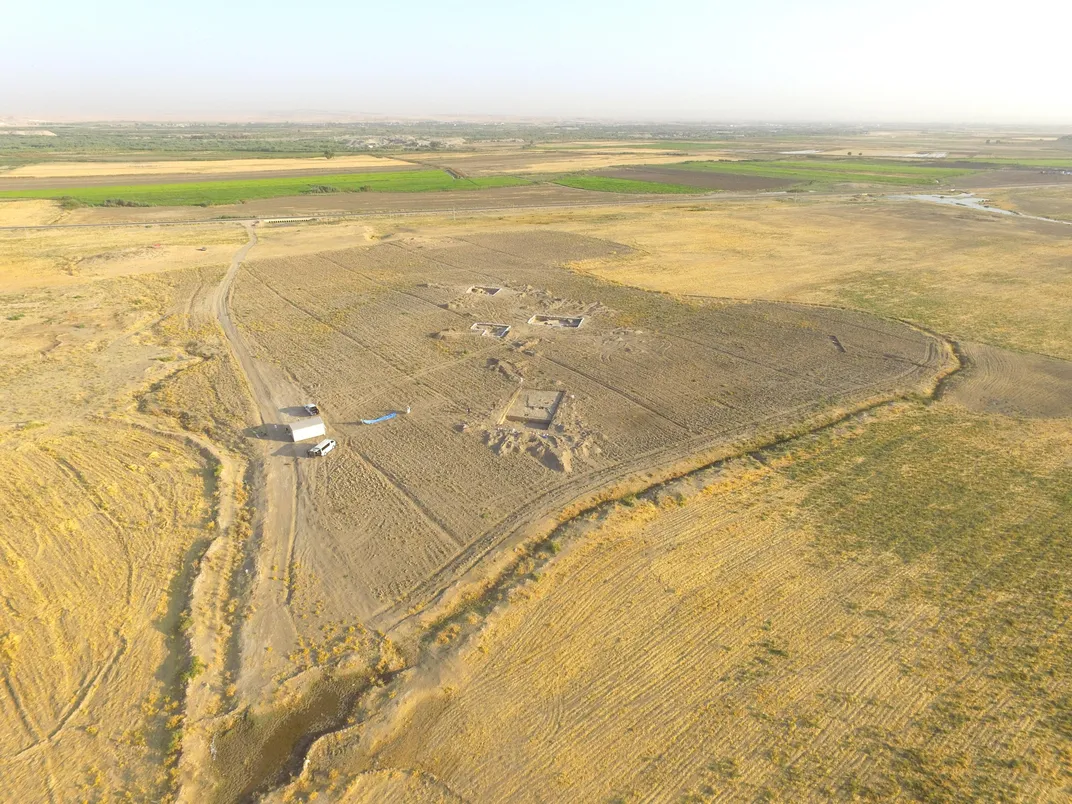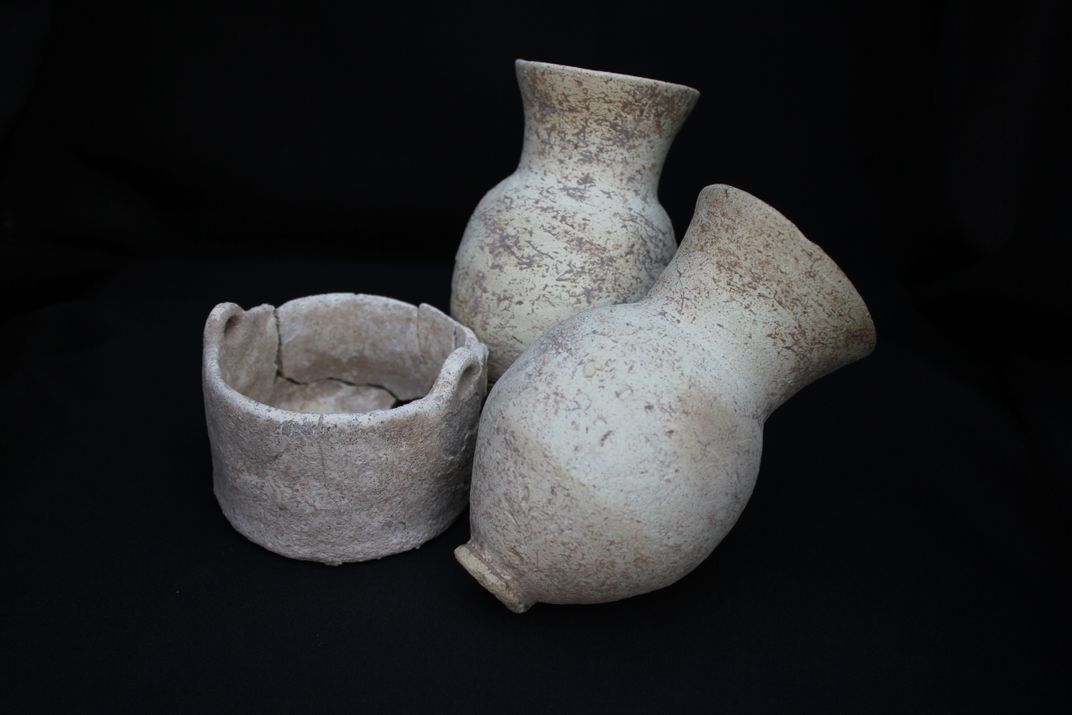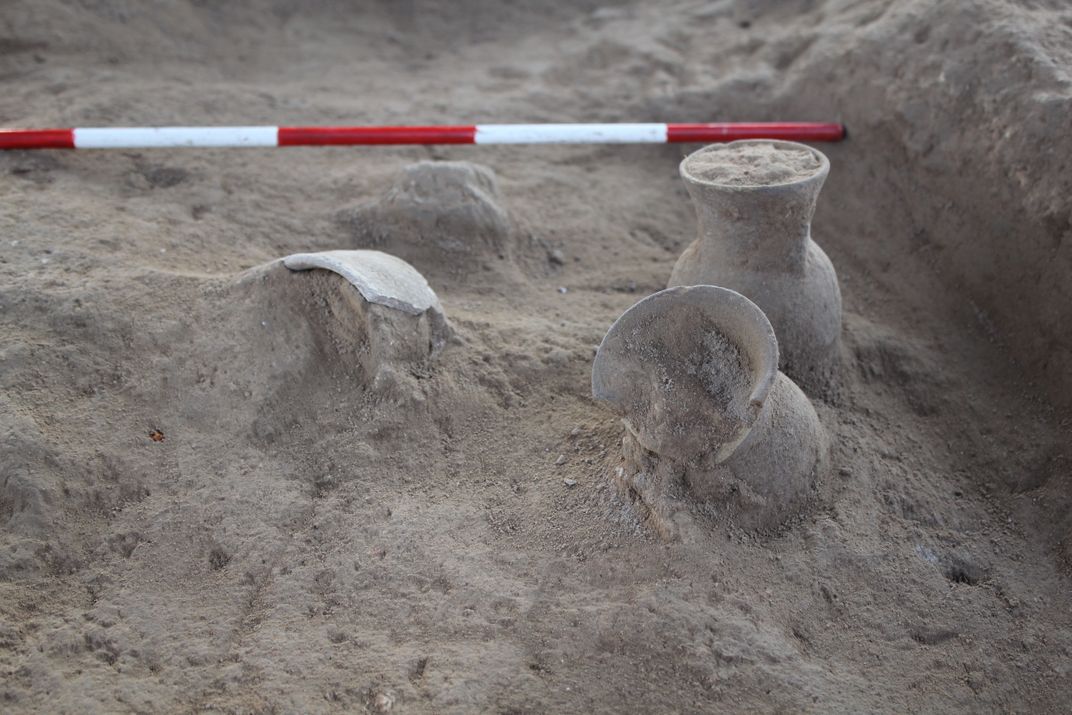Ancient Ceramic Cups Reveal Oldest Direct Evidence of Beer in Mesopotamia
Researchers are working on resurrecting the recipe
/https://tf-cmsv2-smithsonianmag-media.s3.amazonaws.com/filer/18/7e/187e9804-a886-488c-86a0-3b44bbcba511/drinkingcupsbeingexcavatedatkhanimasi2016.jpg)
Archaeologists have long known beer was important in the ancient world, but mainly from writings and drawings—finding actual archaeological evidence of the fermented beverage has been a major challenge.
But archaeologists have now employed a new technique to detect beer residues in nearly 2,500-year-old clay cups dug up in a site in northern Iraq.
“What Elsa [Perruchini] has demonstrated is the chemical signature of fermentation in the vessels that also contains the chemical signatures consistent with barley,” says Claudia Glatz, a senior lecturer in archaeology at the University of Glasgow and a coauthor of a study published recently in the Journal of Archaeological Science. “Putting those together is the interpretation that this is barley beer.”
The use of the technique will likely prove groundbreaking, giving archaeologists a chance to find beer at other excavations. But it is also helping Glatz and Perruchini, a PhD archaeology student at the university and the lead author of the study, understand more about the Babylonian Empire’s outer reaches during a period of cultural upheaval.
Archaeologists have long known beer has been around in Mesopotamia from iconography which showed beer drinking and references to the beverage in old accounting texts describing beer given as rations. Among the best known examples are those found in the Sumerian Hymn to Ninkasi dating to roughly 1800 BC. A beer recipe in the form of a poem, the text praises the beer goddess Ninkasi for soaking malt in a jar and spreading mash on reed mats, among other things.
Further references to beer can be found in the Epic of Gilgamesh – a Mesopotamian poem considered the oldest surviving work of literature—in which Enkidu, a "wild man" who grew up in the forest, drinks seven jugs of beer and decides he likes civilization enough to become Gilgamesh's sidekick.
“[Beer] is a quintessential Mesopotamian food stuff,” says Glatz. “Everyone drank it but it also has a social significance in ritual practices. It really defines Mesopotamian identities in many ways.”
The earliest physical trace of beer dates back to the late fourth millennium BC in present day Iran at a site called Godin Tepe, where archaeologists found what is known as beerstone, a chemical byproduct related to the brewing process and visible to the eye, on ancient ceramic material.
But Perruchini got downright microscopic, examining the chemicals present in the residues clinging to the clay of old cups and jars. She and Glatz are involved with a larger archaeological project at the site, called Khani Masi, exploring the evidence of imperial expansion of the Babylonians into the Diyala River valley. The area, in present day Kurdistan in northern Iraq, is key because it formed a travel hub, connecting the lowlands where some of the world’s first cities and imperial powers were formed with the resource-rich Zagros Mountains.
“Those are very important long distance exchange routes that are leading through this area,” Glatz says.
The excavated section of Khani Masi Perruchini and Glatz are working on dates from 1415 BC to 1290 BC, the late Bronze Age, according to the material evidence such as pottery and the evidence of burial practices excavated. Perruchini was interested in seeing how the people who lived in the area identified culturally, and what better way to get to the bottom of this than examining the food and drink they consumed?
Perruchini says that she first tried to use more traditional chemistry techniques to test the residues, but found the results had been contaminated.
“During an excavation, usually people are touching everything, so it’s going to leave residuals on it,” she says.
One particularly troublesome contaminant comes from the sunscreen often used in sun-drenched digs. As Perruchini notes, some chemical compounds in sunscreen are similar to wine, which could be confusing archaeologists in some cases.
Perruchini decided to take the lab directly to the field, handling freshly excavated bowls or cups with gloves to get more reliable results before anyone else got their hands on them.
“This isn’t something that is discussed a whole lot in the organic residue work in archaeology,” Glatz says. “So Elsa’s method is actually very important in gaining reliable archaeological results – that is not something that has happened so much in the past.”
Perruchini then analyzed the distinct compounds of the residues using gas chromatography, a technique that separates the various compounds present in a mixture. Gas chromatography had not been used in archaeology to examine a collection of compounds to identify something like beer, and the method allowed her to get very specific in her analysis. The team could ignore any contemporary chemicals, while an analysis of soil samples taken from outside the clay vessels allowed them to rule out any soil contamination which could have affected the residues over the past two millennia and “only focus on archaeologically significant compounds.” They then compared the remaining compounds with residues left from modern-day beer samples and found they matched.
“It’s actually very affordable,” Perruchini says about the process, adding that other archaeologists should be able to repeat her technique to identity beer or other residues in ancient remains.
“They were really able to get a gold mine of information out of these pots,” says Mara Horowitz, an archaeology lecturer at Purchase College at the State University of New York who was not involved in the recent work. “It looks like they have done what we’ve all been dreaming about doing.”
She adds that it’s a pity that so many cups already excavated can no longer be examined in this way, since they have likely already been contaminated by modern chemicals.
Augusta McMahon, a reader in Mesopotamian archaeology at the University of Cambridge, agrees that many archaeologists – herself included – haven’t been careful enough when handling old pots and other material evidence, other than keeping certain objects within the protocols required for radiocarbon dating. She added the study was “very exciting” and “good science.”
But both McMahon and Horowitz are also interested in the social aspect of the study and what it means.
According to iconography and excavations from sites older than Khani Masi, Mesopotamians usually drank beer from straws in a larger communal jar around the third millennium BC. But in the subsequent millennium, these larger beer jugs start to give way to individual vessels.
“We have this explosion of a very diverse range of drinking cups,” Glatz says, adding that archaeologists in the past assumed the “daintier vessels” were used for wine. But their chemical analysis shows they held beer.
Horowitz says that the shift to these cups gives archaeologists a sense of social processes, as well as marks of status and power depending on the degree of work that went into their design.
“Interactions at a site like Khani Masi can really give us a sense of what’s going on in a local scale,” she says.
Khani Masi was contemporary with the Kassite rule of the Babylonian empire in Mesopotamia and likely under Kassite control. The Kassites, who likely originated from the Zagros Mountains, assimilated many of the previous Mesopotamian cultural traditions and had diplomatic relations with other empires such as the Assyrians and the Egyptians.
“Khani Masi very much looks like another outpost if you like, or a settlement of Kassite origin in some ways,” Glatz says. But their analysis of the cups shows that while it may have sat near the edges of the empire, the locals drank beer similar to other Mesopotamians, indicating that cultural practices from the center of the empire had spread to the fringes.
Beer was important to the Mesopotamians because the malting process helps to preserve the grains for longer, while fermentation increased the grains' nutritional value.
Or, in the words of McMahon, “It’s what most people drink because the water is not so good.”
Of course, the mild buzz was a draw, too – even the Hymn to Ninkasi notes the wonderful feeling and blissful mood of drinking beer.
Without a fridge handy, the stuff wouldn’t have lasted very long. “Mesopotamians would have been brewing beer constantly,” Glatz says.
The question on everyone's minds, of course, is how the beer tasted. Perruchini and more of Glatz’s students are attempting to find out by brewing beer using techniques described in the Hymn to Ninkasi and ingredients which they think would lead to residues similar to those they’ve found at Khani Masi.
The trouble is, there were a number of types of beer described in old Mesopotamian texts, whether golden, red or dark ales, and Perruchini and her colleagues are uncertain of all the ingredients. Unlike other researchers who recently tried to reproduce 4,000-year old Hittite beer with tasty results, Perruchini says that they have not even tasted the stuff they brewed in their class yet.
“It smells so terrible,” she says.
/https://tf-cmsv2-smithsonianmag-media.s3.amazonaws.com/accounts/headshot/joshua-learn_copy.jpg)




/https://tf-cmsv2-smithsonianmag-media.s3.amazonaws.com/accounts/headshot/joshua-learn_copy.jpg)